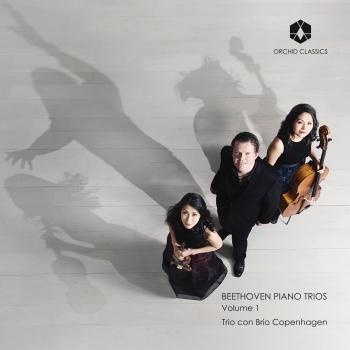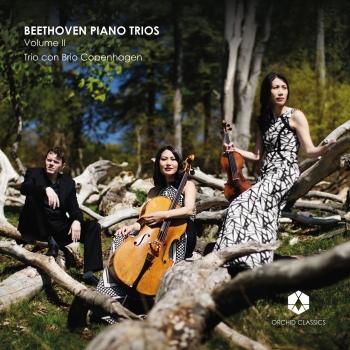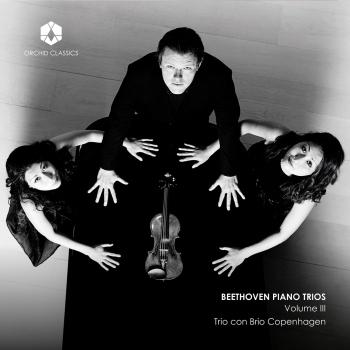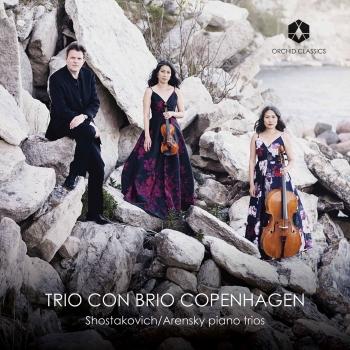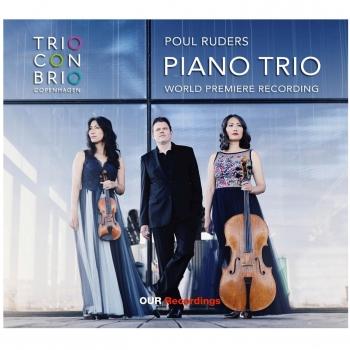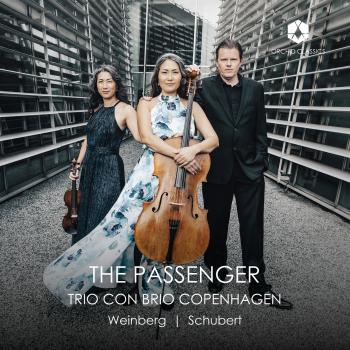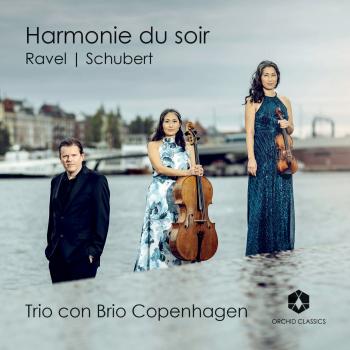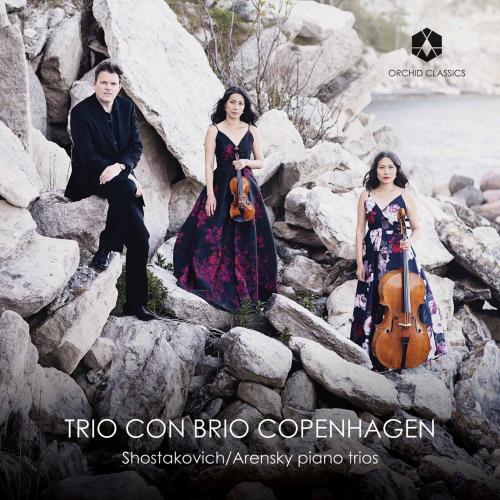
Shostakovich & Arensky: Piano Trios Trio con Brio Copenhagen
Album Info
Album Veröffentlichung:
2021
HRA-Veröffentlichung:
19.11.2021
Label: Orchid Classics
Genre: Classical
Subgenre: Chamber Music
Interpret: Trio con Brio Copenhagen
Komponist: Anton Stepanovich Arensky (1861–1906), Dmitri Shostakovich (1906-1975)
Das Album enthält Albumcover Booklet (PDF)
- Dmitri Shostakovich (1906 - 1975):
- 1 Shostakovich: Piano Trio No. 1 in C Minor, Op. 8 "Poème" 12:25
- Anton Arensky (1861 - 1906): Piano Trio No. 1 in D Minor, Op. 32:
- 2 Arensky: Piano Trio No. 1 in D Minor, Op. 32: I. Allegro moderato 12:00
- 3 Arensky: Piano Trio No. 1 in D Minor, Op. 32: II. Scherzo. Allegro molto 05:34
- 4 Arensky: Piano Trio No. 1 in D Minor, Op. 32: III. Elegia. Adagio 06:47
- 5 Arensky: Piano Trio No. 1 in D Minor, Op. 32: IV. Finale. Allegro non troppo 05:34
- Dmitri Shostakovich: Piano Trio No. 2 in E Minor, Op. 67:
- 6 Shostakovich: Piano Trio No. 2 in E Minor, Op. 67: I. Andante 08:03
- 7 Shostakovich: Piano Trio No. 2 in E Minor, Op. 67: II. Allegro con brio 02:56
- 8 Shostakovich: Piano Trio No. 2 in E Minor, Op. 67: III. Largo 05:17
- 9 Shostakovich: Piano Trio No. 2 in E Minor, Op. 67: IV. Allegretto 10:50
Info zu Shostakovich & Arensky: Piano Trios
The two Russian composers featured on this album lived through turning points in their country’s history. Arensky died in 1906, the same year Shostakovich was born, and their output charts the trajectory of Russian and Soviet political and artistic history during those years. Arensky’s ardent Piano Trio No. 1 was written in 1894, when Russian Romanticism was at its peak. Inspired by young love, the 17-year-old Shostakovich wrote his Piano Trio No. 1 Poème in 1923 in Petrograd (St. Petersburg), finding expression for strong personal emotions via a musical language influenced by film scores. Just over 20 years later, in 1944, Shostakovich wrote his Piano Trio No.2. By making use of Jewish music for the first time, he gave the greatest tragedies of the age a voice, while at the same time creating a music that displays an irrepressible spark of life.
Shostakovich’s Piano Trio No.2 “has been one of the key works in our repertoire since the very beginning of our trio career,” the ensemble explains, noting that the wait to record it was an intentional artistic choice. “We have been waiting many years until we felt ready to make a recording that we feel respects the depths and many layers that this music has.
“For us the piano trio is somehow similar to a confession, a bitter description of a society and war without too much hope.” But through this music that conveys the depths of human emotions during times of great historical turmoil, Trio con Brio Copenhagen hopes to evoke something that can also inspire and uplift listeners today. “I think listening to these compositions hopefully can make us reflect and appreciate what we have.”
Trio Con Brio Copenhagen
Trio con Brio Copenhagen
There are times when two plus two can equal three. Trio con Brio Copenhagen is one such instance, where family ties, cultural blending, and musical connections all converge to color, shape and energize the concerts they present worldwide. Korean sisters Soo-Jin and Soo-Kyung Hong and Danish pianist Jens Elvekjaer created the Trio in Vienna in 1999 with the concept of pairs coming together. The sisters had played together since childhood, and Jens Elvekjaer and Soo-Kyung Hong (who are now married) had played piano and cello duos together for years. According to Mr. Elvekjaer, "We have always felt that this ‘two and two equals three' dynamic provides a uniqueness and intensity to all of our performances.
"The strong personal bonds among the three of us greatly affect the way we conceive music together. We can be one hundred percent honest with each other in rehearsal and performance, and our different cultural backgrounds have provided an unusual perspective that shapes all that we do. It is a process of thinking without boundaries, cultural or otherwise, while staying within the great traditions that the music needs."
This high quality has been recognized not only by audiences and critics, but by some of the most important and renowned musicians of our time. In 2005, Trio con Brio Copenhagen was the recipient of the Kalichstein-Laredo-Robinson International Trio Award, one of the most coveted in the world of chamber music. This biennial award, with a panel of prominent musicians as judges, carried with it appearances on twenty major concert series across the United States, including at New York City's Carnegie Hall, thereby introducing an extraordinarily accomplished "rising" piano trio to American audiences.
The Trio was praised from the time of its inception. About the Trio's debut CD, the American Record Guide wrote: "One of the greatest performances of chamber music I've ever encountered...What stands out from this ensemble is the range of tone and sound...They command an amazing range of timbres. Melodies sing with an aching sweetness, or seduce with wild eroticism, or haunt with impenetrable mystery." Gramophone magazine wrote: "It's easy to see what so impressed the judges...[the] performances can compete with the best available...airtight ensemble...a superb, greatly gifted chamber group."
The Trio first commanded international attention with a performance that took the highest prize at Germany's prestigious ARD-Munich Competition in 2002. Since then, it has won First Prize in additional competitions: Italy's Premio Vittorio Gui (Florence), Norway's Trondheim Chamber Music Competition, and the Danish Radio Competition. The ensemble also won the "Allianz Prize" for Best Ensemble in Germany's Festspiele Mecklenburg-Vorpommern, Second Prize in the Vienna Haydn Competition, and the Premio Trio di Trieste in Italy. Critics have praised the Trio for its "sparkling joie de vivre" and "magic dialogue"; a review of its performance at the Salzburg Mozarteum stated, "They cast a spell over their audience...so alive, so musical...ravishing."
Trio con Brio Copenhagen's busy schedule includes major concert halls in the U.S., Europe and Asia, such as Tivoli Concert Hall (Copenhagen), the Concertgebouw (Amsterdam), Carnegie Hall (New York City), Lincoln Center's Avery Fisher Hall (Mostly Mozart Festival, twice in 2009), the Konzerthaus Berlin, the Mozart-Saal (Vienna), Herkulessaal (Munich), Beethoven-Haus (Bonn), the Musikhalle (Hamburg), the Mozarteum (Salzburg), the Seoul and Sejong Arts Centers (Korea), Bunka Kaikan (Tokyo), Teatro Olimpico (Vicenza, Italy), the Båstad Chamber Music Festival (Sweden), and the Bergen and Trondheim Chamber Music Festivals (Norway).
Booklet für Shostakovich & Arensky: Piano Trios










